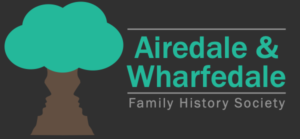Grave Concerns
Speaker: Stephen Miller
The Wharfedale Family History Group met at the Salem Church Hall on Thursday 7 February. Chairman Lynda Balmforth opened the meeting and welcomed speaker Stephen Miller our society’s webmaster and co-founder of Leeds Indexers (now Yorkshire Indexers) who presented an entertaining and informative illustrated talk about his Grave Concerns.
As a dedicated family historian Stephen is rather fond of cemeteries since he first searched for family graves in Harehills Cemetery. Having secured a map of this cemetery he began indexing the graves there but returning one day to resume his task he was shocked to find that a large number of stones had been vandalised. This incident spurred him and like-minded friends to set up the Leeds Indexers as they set about the enormous task of indexing cemeteries in the Leeds area before more gravestones were lost.
Sadly this can happen for any number of reasons such as ground subsidence, weathering, neglect, vandalism and deliberate cemetery clearance either for development or ease of maintenance. Many former cemeteries have been lost such as the Quaker burial ground site which is now occupied by Asda House and its carpark in Leeds. Early OS maps show the large graveyard of Leeds Parish Church, St Peter’s which was subsequently intersected by the railway and the final remaining section providing space for Leeds bus station. The large municipal Woodhouse General Cemetery opened at St George’s field in 1835 but by the 1930s it was terribly neglected and in 1965 wholesale clearance of the gravestones took place which led to the formation of the Leeds Cemetery Defence Organisation. A sparse number of listed memorials remain including the Firefighters’ Memorial but many notable gravestones have been lost such as that for well-known Yorkshire artist Atkinson Grimshaw (1836 – 1893). 105 war graves were also removed from the site and replaced by a screen wall of names in Lawnswood Cemetery. 43 bodies from the vaults of the former St James Church, New York Street were re-interred when the site was demolished and as yet a list of their names remains illusive.
Many local councils have conducted or are in the process of ‘wobble testing’ grave stones in their cemeteries, marking out stones for laying flat or removal where they are considered a safety risk. Memorials are also stolen from cemeteries, it must have taken a lot of effort to steal a 12’ high memorial from Beckett Street Cemetery in 2003. The marble headstone for William Forster 1818 – 1886 (Bradford MP, education reformer and local mill owner) went missing from God’s Acre Cemetery in Burley in Wharfedale in 2008 and has since been replaced with a replica stone.
Burial registers, grave books and cemetery maps are important aids in the task of indexing a cemetery as not all graves are marked by a stone and they can provide information where the stones have been lost or are indecipherable. Leeds Indexers have made use of such records (copies of Leeds burial records and an index of cremations are kept by Leeds Library). Original records are also at risk of destruction such as water damage to the Lawnswood cremation registers and the recent wanton vandalism of the remembrance books kept there.
It is not all bad news however. Many cemeteries have been recorded by local family history societies and other groups. Permission to do so must be obtained and great care taken not to damage gravestones. Leeds City Council acted recently to rescue a number of gravestones at Beckett Street Cemetery by restoring the ground and re-setting stones. These include the ‘guinea graves’ where many poor were laid to rest and their names recorded on the reverse and front of stones. A good number of Friends Groups have also been established to protect and preserve cemeteries such as the Friends of Beckett Street Cemetery (www.beckettstreetcemetery.org.uk) who have transformed a once dangerous, neglected and inaccessible graveyard. The recently formed Friends of Hawksworth Cemetery have set about preserving the cemetery there which had fallen into a sorry state and have established an ‘adopt a grave’ scheme. The missing burial registers for Hawksworth miraculously turned up in an Otley office together with a number of burial certificates.
Grave recording can be a hazardous occupation as Stephen learnt early one morning as he photographed stones when he fell into a large burial hole. Emerging unhurt he gave an early dog walker quite a shock. However the recording and maintenance of our cemeteries not just for family historians but also for those who visit to remember loved ones and preserving our heritage is a most worthy task.
President Stanley Merridew gave a warm vote of thanks following questions and comments from the audience. The Group’s next meeting will take place 7.30 pm on Thursday 7 March at the Salem Church Hall, Main Street, Burley when Nigel Grizzard will present his talk, History of Ilkley’s Jewish Community. Members and non-members all welcome, refreshments provided.
Report by Susanne Young
